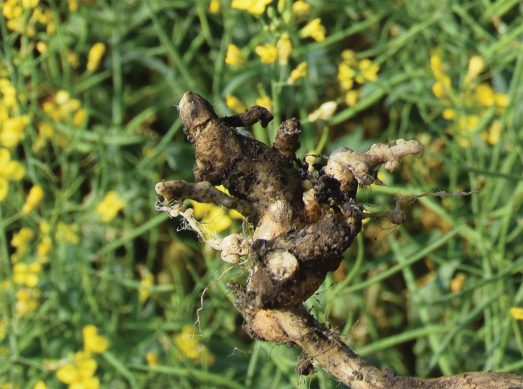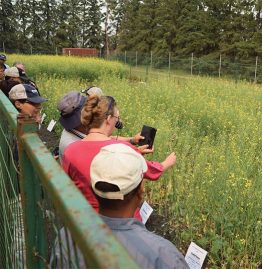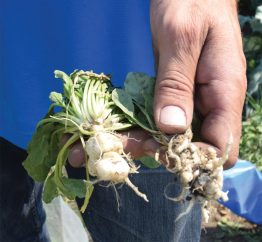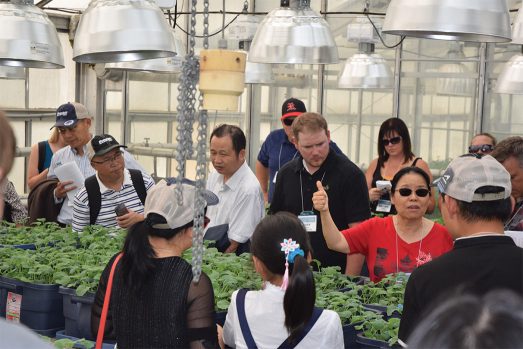Global concern, local action: International Clubroot Workshop
Agronomist Chelsie Will was stunned to find clubroot in her territory in east central Saskatchewan this past summer. It was shocking given how far away the field was from any known clubroot hotspot. When Will went to tell the farmer, Dale Peterson, about her discovery, the first thing he saw was the serious look on her face. “She’s normally so easy going but was really shook up when she came into the shop,” Peterson says. “Then she told me she found clubroot in my field.”
“After the conference, we were a lot more comfortable talking about our clubroot situation.”
Will and Peterson took immediate action; they registered for the International Clubroot Workshop, which was August 7-9 in Edmonton, hoping to learn as much as they could about the disease. A memorable take-home from the event, Will says, was finding out that clubroot is a serious but manageable disease in brassica-growing regions around the world.
“After the conference, we were a lot more comfortable talking about our clubroot situation,” Will says. So two days after the workshop ended, Peterson hosted an impromptu clubroot training session in his field, using word of mouth to share the invite. Eighty people came.
Clubroot-resistant seed is just one step in long-term management
Clubroot was found in canola in Canada for the first time in 2003 and within six years seed companies released the first clubroot-resistant (CR) canola varieties for the Canadian market. But by 2013, patches of severe clubroot were showing up in fields planted to CR varieties and as of 2018, 104 fields are confirmed to have clubroot pathotypes that overcome the most common CR varieties on the market in Canada.
Genetic resistance can be very effective and is the easiest tool for farmers to use, but these resistance traits need help from a multi-pronged approach to keep clubroot spore counts low in farm fields. High spore levels increase disease levels. High spore levels also increase the risk that virulent pathotypes will reach economically-damaging levels. By keeping spore counts low in the field, farmers can protect the effective lifespan of CR genes.

Five steps to keep spore counts low
1. Delay arrival of clubroot to a field
“The spread of clubroot in Western Canada has been rapid for a soil-borne disease.”
Attendees at the International Clubroot Workshop heard this message often: “It is easier to manage clubroot disease when you don’t have it.” Clubroot is a soil-borne disease and heavily-infested areas can have millions of spores per gram of soil. Preventing the introduction of clubroot is about preventing soil movement onto and around the farm.
Knock dirt off equipment. Rough cleaning of equipment removes 90-95 per cent of soil and spores. Washing with compressed air or a pressure washer brings that up to 99 per cent. Mist-on disinfectant, such as a two-per-cent bleach solution, can take that to 99.9 per cent. Based on a recent study by Michael Harding with Alberta Agriculture, the most effective, cheapest and most readily available cleaning solution is bleach. There is no close second.
Think biosecurity. When buying used equipment or hiring custom operators, check that the machinery is clean before it arrives on the farm. If not clean, what is the risk that hitchhiking soil has clubroot? Farmers can demand the same inspection of machinery digging pipelines or installing oil and gas infrastructure on their land.
Reduce erosion. Wind and water erosion of soil will move clubroot spores, and reduced tillage will reduce erosion of infested soil.
Keep tools, boots and tires clean. While this may represent very small amounts of soil movement, people such as agronomists and crop inspectors who move from field to field will want to take measures to reduce the risk that they’re moving the spores. Park on the road or wash the vehicle before moving to the next farm. Use booties or a bleach-bath for boots.
Entry and exits. Field entry points where machinery unfolds and starts working are often the first and most heavily infested areas. Consider planting a small square of permanent grass at field entry points, providing a non-host-crop area for soil to drop. Another idea is to have a separate field exit, also grassed, so machinery leaves an infested field from an area likely to have less clubroot.
2. Scout early and often
Clubroot is now found across the canola-growing region of Canada, and though it arrived later in Western Canada than most of brassica-crop growing areas of the world, it seems to thrive here. “The spread of clubroot in Western Canada has been rapid for a soil-borne disease,” says Stephen Strelkov, clubroot researcher at the University of Alberta.
“The big eye opener for me was that my field with clubroot was a good looking field of canola.”
Dig up plants and look for galls in all canola fields. Go to clubroot.ca to see what small galls look like. If uncertain, send plants away for DNA tests. Because the goal is early detection, include random searches in fields that may be showing no signs of disease. “The big eye opener for me was that my field with clubroot was a good looking field of canola,” Peterson says. But the infested area turned out to be much larger than he or Will expected.
Random searches for galls in high-risk areas of a field will improve the chance of finding patches that are small enough to manage. High-risk areas include field entrances but also low moist areas where soil runoff can deposit spores and where infection is most likely (due to the moisture).
Low pH areas can also be higher risk, but we don’t have a scale to quantify how risk varies by pH. We know from lab analysis that clubroot galls do not grow well with pH of 7.3 or higher, and there is some indication that lower pH means continually higher risk because clubroot seems to thrive in acidic soils. But higher pH does not mean immunity, as Chelsie Will discovered. “For most of my area a pH of 7.3 would be considered low – and yet we have clubroot showing up,” she says.
3. Contain clubroot patches
Clubroot patches identified early enough and small enough can be managed in various ways to reduce the clubroot spore load in those patches and prevent clubroot from spreading beyond that patch. Patch management techniques include:
Rogue. If the patch is small enough, pull up all the plants that have galls. Then cut off the galls and burn them. This is an immediate and effective way to destroy those galls.
Lime. Increasing soil pH in areas with clubroot can reduce clubroot severity. Brassica vegetable growers around the world have been using lime for decades for this purpose. The increase in pH has the added bonus of increasing availability of other key nutrients. The Canola Encyclopedia lists the factors that can limit plant growth on acid soils: toxicity of hydrogen ions, aluminum, iron, or manganese; deficiency of calcium, magnesium, potassium, phosphorus, boron, nitrogen or molybdenum; reduced organic matter breakdown and nutrient cycling by microflora; and reduced uptake by plant roots and inhibition of root growth.

New research projects will give farmers and agronomists more detail on best lime sources, appropriate application rates and timing, and possible limitations of lime to bring very low pH soils up to a low-risk level. On this last point, lime might not be able to push past a soil’s “buffer pH” unless applied rates are very high. As it is, it can take a few tonnes of lime per acre to move soil up just one pH point.
Nicole Fox, Master’s student in plant pathology at the University of Alberta, leads one of the lime research projects. “Low pH, clubroot-infested soil treated with hydrated lime significantly reduced the number and size of galls on the susceptible canola roots,” Fox says, adding, “Liming can reduce the selection pressure on the current resistant cultivars planted, as well as decreasing the amount of spores reproducing in susceptible volunteer canola and even crucifer weed species present in the field throughout the crop rotations. However, types of lime, application style and timing will still need more research.”

infested fields.
Targeting small early-identified patches is preferred because trucking the required rates can be expensive. When considering a lime source, look for a high concentration of calcium carbonate (CaCO3) or hydrated lime (Ca(OH)2) per tonne and consider purity of the source. Large-grit lime could take years to be fully effective but it is much easier to handle and apply. Powdered lime acts fast but is hard to handle and spread in large volumes. On application style, lime is often roto-tilled into the soil in research plots, but this tillage will add to the spread of clubroot. Farmers need reduced-tillage or surface-
applied liming techniques that work.
Reduce tillage. Because a single gall produces millions of spores and the decomposing gall will release the spores into the surrounding soil, tillage will disperse the spores to a larger area than if the soil is left undisturbed. Dan Orchard, Canola Council of Canada agronomy specialist in central Alberta, says many of the heavily infested fields in his area “have been exposed to aggressive tillage”.
Grass. Seed the patch to a non-host grass such as ryegrass that can fill in quickly and tie up the soil to prevent wind and water erosion. While the patch is in place, farmers will need to control host weeds, which include volunteer canola, flixweed, shepherd’s purse, stinkweed and mustard. Leave the patch until soil surveys indicate spore levels are very low or zero.

Fumigation (or solarization). Mary Ruth McDonald, clubroot researcher at the University of Guelph, has had success reducing clubroot spore counts in small patches by fumigating the soil (with Vapam) and then covering the patch with film. Interestingly, the film covering may actually work on its own, McDonald observed. The film captures heat, creating a hot zone that seems to kill clubroot resting spores.
Fungicide. At the International Clubroot Workshop, Japanese researcher Kenji Wakayama explained how farmers in his country use fungicide to manage clubroot, but Wakayama says it would not be economical in large fields. Sheau-Fang Hwang, clubroot researcher with Alberta Agriculture, led some work looking at fungicides applied in the soil and as a seed treatment. Hwang’s study concluded that seed treatments “will not work” on existing infestations and the only soil-applied product that actually reduced clubroot required rates too high to be safe and too expensive to be practical. Plus the product is no longer available in Canada.
For any patch management technique to be effective, patches need to be small and clubroot has to be identified very early. By the time plants are showing symptoms, the whole field could be infested to the point where patch management no longer works.

4. Rotate crops. One in three, minimum
Evidence from three rotation studies done in Canada (two at Normandin, Quebec, one in Alberta) suggests that two years between host crops is the minimum rotation to manage clubroot spores in a field. Thomas Ernst, who did the Alberta study and now works with Corteva, observed an eight- to 20-fold drop in resting spore concentrations with a two-year break after growing clubroot-resistant canola. However, the spores that survive that two-year break are shown to be fairly hardy, possibly surviving for many years beyond that. Mary Ruth McDonald observed that in her studies. Ernst found the same. Ernst adds that if the break is only one year, resting spore numbers never drop enough to provide any reduction in risk.

Crop rotation has mixed applications around the world. In Europe, clubroot has forced a longer rotation between oilseed rape (OSR) crops. Fiona Burnett, plant pathologist and professor at Scotland’s Rural College, has U.K. data showing that OSR grown on clubroot-infested fields in a one-in-three rotation has 63 per cent of the yield potential of OSR grown on a non-clubroot-
infested field. This result improves to 65 per cent for a one-in-four rotation, 74 per cent for one in five and 80 per cent for one in eight. “We tend to recommend a one-in-five rotation as the difference between three and four years is so small,” Burnett says. Across Europe, crop rotation of at least one year in three and usually longer is recommended for large-acre brassica crops.
For small plots of brassica vegetables, which are high-margin, intensively managed and often core foods for the local culture, rotation is a last resort. Instead, farmers walk their vegetable fields many times per year and have learned to spot early symptoms of clubroot. Individual plants are often pulled and the galls destroyed. Small patches are also given large amounts of lime or are fumigated or both to manage the disease. These measures would not be economical on large fields.
5. Grow CR varieties as soon as clubroot is in the area
The Canadian recommendation is for farmers to use clubroot-resistant (CR) varieties as soon as clubroot arrives in the area. The CR trait will prevent most infection, which will help to keep spore counts low in fields that already have lower counts. With fewer resting spores in the soil, the risk of building up virulent pathotypes is reduced.
When spore counts reach high levels, clubroot is more easily moved from field to field, clubroot will cause yield loss in susceptible canola (even with a four-year rotation) and clubroot will overcome CR traits. “This has been demonstrated scientifically and practically. Every field where resistance has failed had high spore loads,” says Clint Jurke, Canola Council of Canada agronomy director.
Two of the biggest clubroot research efforts around the world are (1) to find new effective resistance genes and (2) to identify all clubroot pathotypes that can attack brassica crops. In time, these efforts could lead to a system where farmers can identify clubroot pathotypes in a field and then choose a variety with resistance to those pathotypes. But while genetics show a lot of promise, relying on genetics alone is not enough. “We do not recommend growers use CR varieties in isolation. Rotation and weed control are the other tools required to reduce spore buildup,” Jurke says.
Stephen Fox, canola breeder with DL Seeds, noted at the International Clubroot Workshop that it takes a lot of effort to insert a new gene into a high-performing commercial variety that also has all the other traits growers want.
“What do farmers want breeders to focus on? Tackling CR or boosting yield?” Fox asks. “If growers don’t protect the CR traits we have, then our focus as breeders will shift to CR, which could mean other areas – like advancing yield – may stall.”
During a panel presentation near the end of the International Clubroot Workshop, six leading clubroot researchers from around the world were on stage taking questions. One question was: What’s the one thing you’d tell farmers to do to manage clubroot? One recommended to keep clubroot away for as long as possible. One recommended to scout now to catch it early. The other four answered: “Longer rotations”.
What will Dale Peterson do?
Farmers and agronomists can go to clubroot.ca to find a list of labs that analyze soil and plants for clubroot DNA.
Peterson ordered his clubroot-resistant canola seed for 2019 even before he had harvested the 2018 crop. He will also start a transition to a three-year rotation. “When I got home from the clubroot workshop in Edmonton, I figured I was going to a three-year rotation no matter what,” he says, but then he ran the numbers and realized this quick transition would be a tough economic blow. He and most farmers in the area are in a canola-wheat rotation and stretching rotations is not easy. “Economically, we can’t go back to the one in four or one in six rotations we used when we first started growing canola,” Peterson says.
He’s thankful for the breeders who brought CR varieties to market so quickly, making it possible to keep growing canola at all after the arrival of clubroot. “I give a big thank you to those scientists who tackled this 15 years ago,” he says.





